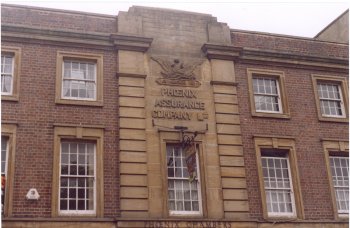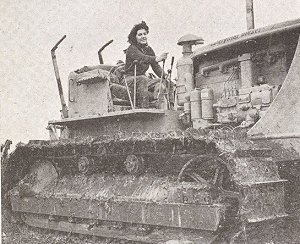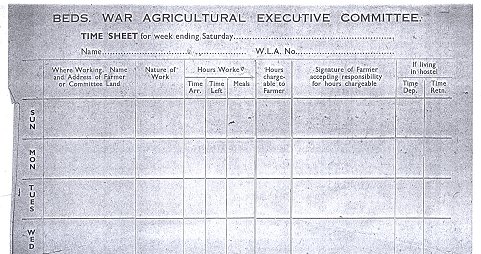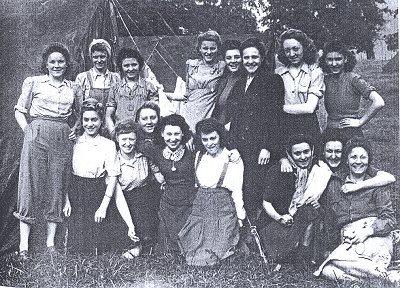Bedfordshire War Agricultural Executive Committee (Beds WAEC)
Bedfordshire Women's Land Army
>
Wartime Farming & Bedfordshire War
Agricultural Committee
Mr. H.J. Humphreys, of Eversholt, was appointed the unpaid Chairman of the Bedfordshire War Agricultural Committee and Mr. E.W. Russell was the salaried Executive Officer. The county headquarters office was set up in Phoenix Chambers, St. Pauls Square, Bedford and the first meeting of the Bedfordshire War Ag was on Tuesday 5 September 1939. Its first instruction was to convert 10,000 acres of grass land into arable land. Amazingly, Bedfordshire farmers were able to have ploughed up 17,000 new acres, ready for the harvest of 1940.

Bedfordshire War Ag. HQ, Phoenix Chambers Bedford
Photograph - Stuart Antrobus
Bedfordshire was still a predominantly rural, agricultural county with 250,000 of its 300,000 acres being farmed (50% grass & 50% arable). Two-thirds of its subsoil was clay and one third (about equally divided) river gravel, greensand and chalk. It was noted for its market gardening, mainly grown on the gravel and greensand but sometimes on the better class of boulder clay in the east of the county, and its wheat, beans and clover.
Bedfordshire WAEC faced a number of problems: how to increase the farmed acreage on the clays, given the impeded drainage, and the low phosphate status of its soils. Farmers on the heavy soils relied less on farmyard manure and more on lime. Once the War Ags got going, they offered a half-cost subsidy for ditching and mole draining. Track-laying caterpillar tractors were brought into use to enable cultivation on those heavy soils, previously avoided by farmers.

Caterpillar tractors were excellent machines for reclamation work
on difficult terrains.
MERL, University of Reading
The average rainfall in Bedfordshire was 24 inches per year (falling occasionally to below 20 inches) and there were frequent periods of long drought. Nevertheless, clay soils could produce excellent swards and wild clover grew freely. One system adopted was the laying down of old arable land, thus enabling exhausted arable fields to be rested and accumulate fertility. Grass fields were broken up and cropped.
Beds War Ag set about reclaiming areas of previously uncultivated land in the county, especially clay bushy land. Underdeveloped building land in a derelict state was taken over. Sandy and sandy loam land, badly infested with rabbits, was brought under control and into use. Five hundred acres of derelict clay land used only for rough grazing was cultivated. Waterlogged and semi-waterlogged land was drained, progressively. Beds War Ag requested that the Internal Drainage Boards (set up by the Great Ouse Catchment Board) recondition the main watercourses and loaned them eleven excavator machines to assist. Common land growing gorse, bracken and such like was farmed for the first time in recent years. All together, the War Ag took in hand 5000 acres of otherwise unproductive land in the county.

Hostel land girls' timesheet which had to be signed each day by the farmer.
Cereals and potatoes were the main crops of the war, but also vital were the vegetables and fruit produced in the market gardens and orchards of the north east of the county, where market gardens were well-established. New crops such as flax appeared in Bedfordshire, vital for the production of war materials such as canvas tents, camouflage, aircraft fabric and parachute-harness.
In the south of the county, Luton Corporations Parks and gardens Committee purchased farming equipment to recondition undeveloped land for the establishment of Borough allotments. Dunstable had a similar project. Those who already had allotments in the county cultivated them with increased vigour. Even the people in the towns were digging for victory and helping to produce some of their own food.
Bedfordshire War Ag also worked in conjunction with the Womens Land Army headquarters in Bedford to both help co-ordinate the flow of labour to the countys private farms and directly employ about half of the countys land girls (about 500 of the maximum number of 1000 by 1943-44). These it housed in a mixture of requisitioned country houses or in a number of purpose-built hutments for 40 land girls, all strategically placed around the county, so that the young women were within about three miles of their usual work. This enabled mobile gangs of young women to go out each morning in small gangs to work on whichever local farms needed their labour, for as long as they needed that labour, and to be returned each evening to their hostel in their own lorries. The land girls were employed directly by the War Ag, who paid them, and the farmers paid the War Ag for their labour on a daily basis. Mr. Whatling was in charge of Land Army labour, for the War Ag, and Mr.Ted Foulkes, its Transport Officer, based at Turners Yard, Goldington.
The War Ag, in association with the Land Army, also appointed and paid YWCA (Young Womens Christian Association) Wardens and Assistant Wardens to look after the welfare of the land girls in each hostel.
In addition to these full-time agricultural workers, the Bedfordshire Land
Corps (sometimes referred to as the Womens Emergency Labour Corp) were
civilians who were either housewives or in employment elsewhere who offered to
work, part-time, on local farms, and were organised by Bedfordshire War Ag,
which provided the transport to get them to and from the farms. Housewives were
shipped out every weekday afternoon to farmers who had requested extra help with
seasonal jobs such as riddling potatoes or hoeing beet, and so on. Others, such
as young women who worked in shops or offices, turned up outside the Corn
Exchange at 6.30pm in the evening and were transported in open-topped lorries to
farms where they worked for three hours at a time. These auxiliary workers were
vital, if farmers were to achieve the increasing targets set them each year of
the war.
who were either housewives or in employment elsewhere who offered to
work, part-time, on local farms, and were organised by Bedfordshire War Ag,
which provided the transport to get them to and from the farms. Housewives were
shipped out every weekday afternoon to farmers who had requested extra help with
seasonal jobs such as riddling potatoes or hoeing beet, and so on. Others, such
as young women who worked in shops or offices, turned up outside the Corn
Exchange at 6.30pm in the evening and were transported in open-topped lorries to
farms where they worked for three hours at a time. These auxiliary workers were
vital, if farmers were to achieve the increasing targets set them each year of
the war.
Bedfordshire War Ag set up three Farming Camps at Blunham, Sharnbrook and Ampthill Park. Paid volunteers from towns and cities spent all or part of their annual summer holiday at these agricultural camps, enticed by the slogan Lend a hand on the land and as an alternative to the holidays by the sea which were no longer possible with barbed wire surrounding many of the pre-war holiday resorts. Some were accommodated in bell tents, others in better equipped huts. Many got very sunburnt, especially the miners from South Wales who were used to working underground.
The further addition of foreign labourers by the use of prisoners of war first Italian prisoners, then German prisoners and of refugee and displaced persons from Europe, boosted the agricultural labour force yet more. Finally, the contribution of teenage schoolchildren boys and girls gave seasonal boosts to the number employed on farms, during the school holidays. When labour shortages became desperate, soldiers would also be called upon, if they could be spared form their normal duties, and American GIs stationed in the northern airfields of Bedfordshire would sometime volunteer to lend a hand of their own volition.
Each year of the war, increasing targets were set for War Ags and farmers to achieve. In 1943, Bedfordshire was set the challenge of cropping an additional 15,000 acres. Wheat and barley were in great demand for bread production, as the Government strove to avoid bread rationing. Only by maximising the use of machinery, fertilisers and labour was it possible. Issuing fertiliser permits was one of the many responsibilities of the War Ag. The elimination of waste and the maximising of efficient ways of working were constantly brought home to farmers through propaganda notices and the issue of 1 million Growmore leaflets.

Volunteer workers at Ampthill "Holiday at Home"
farm camp, 1943
BLARS (Andrew Underwood archive)
Bedfordshire farmers, as in the country as a whole, thanks to the War Ag committee and the land girls and all those who had done their bit to get in the harvests, achieved increases in food output which were miraculous. Nationally, some 6 million new acres were ploughed up between 1939 and 1944. Harvests of wheat, barley and potatoes increased by over 100%; milking cows increased by 300,000; other cattle by 400,000. This was at the expense of fewer sheep, pigs and poultry but enabled the country to completely reverse its reliance on foreign food. In terms of calories, the net output had been quadrupled by 1943-44. By the end of the war, food imports had been reduced from 22 million to 11 million tons and Britain was producing well over 60% of its food. This was despite losing nearly 100,000 skilled male farm workers, who went off to fight, and thanks to the 117,000 women who replaced them.
Stuart Antrobus Historian/Author
Page last updated: 10th March 2014

